I’ve experienced it myself – that eerie moment when your toilet flushes on its own, as if haunted by a mischievous ghost.
But fear not, there are logical explanations for this phenomenon known as phantom flushing.
From malfunctioning flappers to leaky tank bolts, I’ll guide you through the most common causes and their fixes.
No need to fret about water wastage and higher bills, as we explore practical solutions to put your toilet’s paranormal activities to rest.
Key Takeaways
- Phantom toilet flushing can occur due to a worn out or damaged flapper.
- Adjusting the flapper chain can help resolve phantom toilet flushing issues.
- Testing the functionality of the flapper is important in diagnosing and fixing phantom toilet flushing.
- Ensuring proper sealing and preventing leaks can help eliminate phantom toilet flushing.
Causes of Toilet Flapper Malfunction
I need to replace the toilet flapper if it is malfunctioning and causing phantom flushing.
The toilet flapper is a rubber valve that controls the flow of water from the tank to the bowl. Over time, the flapper can become worn out or damaged, leading to issues such as constant running or phantom flushing.
To replace the flapper, first, turn off the water supply to the toilet. Then, remove the old flapper by disconnecting it from the flush valve. Install the new flapper by attaching it to the flush valve and ensuring a tight seal.
Additionally, it’s important to check and adjust the flapper chain to ensure it has the proper amount of slack. This will prevent the flapper from getting stuck or not sealing properly, which can cause leaks or continuous running.
Solutions for Damaged Toilet Flapper
Replacing the damaged flapper is one solution to fix the issue of phantom flushing. When dealing with a damaged toilet flapper, there are several steps you can take to address the problem effectively:
-
Replace the flapper: Installing a new flapper will ensure proper sealing and prevent water from continuously flowing into the toilet bowl.
-
Adjust the flapper chain: Ensure that the flapper chain has the correct amount of slack, allowing the flapper to close fully after each flush.
-
Test the flapper functionality: After making any adjustments or replacements, it’s essential to test the flapper to ensure it is functioning correctly. This involves flushing the toilet and observing if the flapper closes tightly, stopping any water from flowing.
Solutions for Tank Float Issues
One possible solution for a tank float issue is repositioning the float to ensure proper water flow control. Troubleshooting tank float problems is important to prevent phantom toilet flushing and water wastage. Common float problems include a stuck or misaligned float, a damaged or worn-out float, or a float that is set at the wrong level. By repositioning the float, you can ensure that it moves freely and stops the water flow at the correct water level. Adjusting the float level can also help in resolving the issue. Checking for any obstructions around the float and cleaning or replacing a damaged float are additional steps you can take to troubleshoot tank float problems. Testing the float to ensure it stops the water flow properly is crucial for proper toilet functionality.
| Common Float Problems | Solutions for Tank Float Issues |
|---|---|
| Stuck or misaligned float | Reposition the float |
| Damaged or worn-out float | Adjust the float level |
| Float set at the wrong level | Check for obstructions around the float |
| Clean or replace the float if damaged | |
| Test the float for proper functioning |
Solutions for Leaky Tank Bolts
Tightening the tank bolts is a simple and effective solution for addressing leaky tank bolts. When dealing with this issue, there are a couple of key solutions to consider:
-
Tightening the bolts: Start by locating the tank bolts on the bottom of the toilet tank. Use a wrench to tighten them, making sure not to overtighten as it may cause damage.
-
Rusty bolt replacement: If the tank bolts are rusty or corroded, it’s best to replace them. Remove the old bolts and install new ones to ensure a proper seal.
Proper sealing techniques:
-
Use a rubber gasket or washer: Place a rubber gasket or washer between the tank and the bowl to create a tight seal and prevent leaks.
-
Apply silicone sealant: Apply a thin layer of silicone sealant around the bolts to provide an extra layer of protection against leaks.
Other Toilet Running Issues
When dealing with other running issues in my toilet, I should check the fill valve for any damage or blockage. The fill valve is responsible for refilling the tank after each flush, and if it is damaged or blocked, it can cause the toilet to continuously run.
One common issue that can occur is clogs in the overflow tube. The overflow tube is connected to the fill valve and helps regulate the water level in the tank. If it becomes clogged, it can prevent the fill valve from properly shutting off, causing the toilet to run.
Another possible solution is adjusting the water level in the tank. By adjusting the float or the float arm, I can ensure that the water level is set at the appropriate height, preventing any unnecessary running.
Seeking Professional Help
When it comes to toilet issues, some problems can be easily fixed with basic troubleshooting and DIY solutions. However, there are situations where it’s best to call a professional plumber.
Here are some signs of a serious toilet issue that indicate it’s time to seek professional help:
-
Persistent leaks: If you’ve tried tightening bolts or replacing parts but the leaks persist, it could be a sign of a more significant problem, such as a cracked tank or damaged pipes.
-
Frequent clogs: If your toilet is constantly clogging, it may be a sign of a blockage in the main sewer line. A plumber can use specialized equipment to identify and remove the obstruction.
If you notice any of these signs, it’s important to call a plumber to prevent further damage and ensure the problem is resolved correctly. Plumbing professionals have the skills, knowledge, and tools to tackle even the most complex toilet issues. Don’t hesitate to reach out for help when needed.
Frequently Asked Questions
How Can I Determine if the Toilet Flapper Is Malfunctioning?
To determine if the toilet flapper is malfunctioning, there are a few signs to look for. These include water continuously running in the toilet bowl, a weak flush, or the need for frequent toilet flapper replacement.
Are There Any Temporary Fixes for a Damaged Toilet Flapper?
Yes, there are temporary fixes for a damaged toilet flapper. You can try adjusting the flapper chain, cleaning any debris, or ensuring proper sealing. However, it’s best to replace it for a long-term solution.
Can a Tank Float Issue Cause a Toilet to Continuously Run?
Yes, a tank float issue can cause a toilet to continuously run. If the float is not properly adjusted or there are obstructions around it, it can lead to the toilet not stopping the water flow. This can result in high water bills and potential water pressure problems.
What Should I Do if Tightening the Tank Bolts Does Not Stop the Leak?
If tightening the tank bolts doesn’t stop the leak, I would recommend checking the toilet bowl for any cracks or damage. Additionally, make sure the water level in the tank is properly adjusted.
When Should I Consider Seeking Professional Help for a Phantom Toilet Flushing Issue?
If troubleshooting toilet flush issues, it’s best to consider seeking professional help for a phantom toilet flushing problem if the toilet flapper replacement and other DIY solutions fail to resolve the issue.
Conclusion
In conclusion, phantom toilet flushing can be a frustrating and wasteful problem. However, there are various causes and solutions to address this issue.
Just like in life, sometimes things malfunction or break, but with the right knowledge and tools, we can fix them. By replacing damaged flappers, adjusting tank floats, and fixing leaky tank bolts, we can restore balance and efficiency to our toilets.
Remember, if all else fails, don’t be afraid to seek professional help. Let’s take charge of our toilets and conserve water for a better future.










